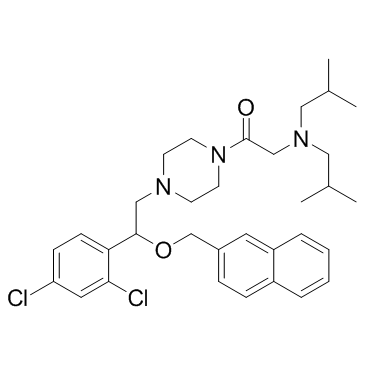| Description |
LYN-1604 is a potent UNC-51-like kinase 1 (ULK1) agonist with an EC50 of 18.94 nM.
|
| Related Catalog |
|
| Target |
EC50: 18.94 nM (ULK1)[1]
|
| In Vitro |
LYN-1604 is a potent UNC-51-like kinase 1 (ULK1) agonist with an EC50 of 18.94 nM in ADP-Glo™ kinase assay. The in vitro kinase assay reveals that the LYN-1604 increases the phosphorylation of mATG13 at ser318 in wild-type ULK1 transfected HEK-293T cells. It is found that LYN-1604-treated cells display a remarkable green fluorescence with MDC staining and the autophagy ratio is increased in a dose-dependent manne. It is also found that LYN-1604 induces remarkable up-regulation of Beclin-1 and degradation of p62, as well as transformation of LC3-I to LC3-II[1].
|
| In Vivo |
Based on the results of tumor volume and weight, it is found that LYN-1604 can significantly inhibit the growth of xenograft MDA-MB-231 cells. The body weights of mice are stable, with no obvious distinctions between LYN-1604-treated and control mice. It also reveals that LYN-1604 induces remarkable autophagy in vivo[1].
|
| Kinase Assay |
Cells or tumor tissues are treated with LYN-1604 for the indicated times. Both adherent and floating cells are collected and western blot analysis is carried out. Briefly, the cell pellets ae resuspended with lysis buffer consisting of 50 mM HEPES, pH 7.4; 1% Triton-X-100, 2 mM sodium orthovanadate, 100 mM sodium fluoride, 1 mM edetic acid, 1 mM PMSF, 10 mg/L aprotinin and 10 mg/Lleupeptin, and lysed at 4°C for 1 h. After 12 000 rpm centrifugation for 15 min, the protein content of the supernatant is determined by the Bio-Rad DC protein assay[1].
|
| Cell Assay |
Cells are dispensed in 96-well plates at a density of 5×104 cells per mL. After 24 h of incubation, cells are treated with different concentrations of LYN-1604 for the indicated time periods. Cell viability is measured by the MTT assay[1].
|
| Animal Admin |
24 female nude mice (BALB/c, 6 to 8 weeks, 20 to 22 g) are used and injected subcutaneously with MDA-MB-231 cells (5×106 cells per mouse). When the tumors reach 100 mm3 in volume (V=L×W2/2), the mice are divided into four groups. Three groups are treated with different doses of LYN-1604 once a day by intragastric administration for 14 days (low dose, 25 mg/kg; median dose, 50 mg/kg; high dose, 100 mg/kg), whereas the control group is treated with vehicle control. During the treatment, the tumor volumes and body weight are measured every day until the end of the study. At the end of treatment, all mice are sacrificed. The spleen, liver, kidney and tumor tissue are harvested, weighed, and photographed, then immediately frozen in liquid nitrogen or fixed in formalin[1].
|
| References |
[1]. Zhang L, et al. Discovery of a small molecule targeting ULK1-modulated cell death of triple negative breast cancer in vitro and in vivo. Chem Sci. 2017 Apr 1;8(4):2687-2701.
|
